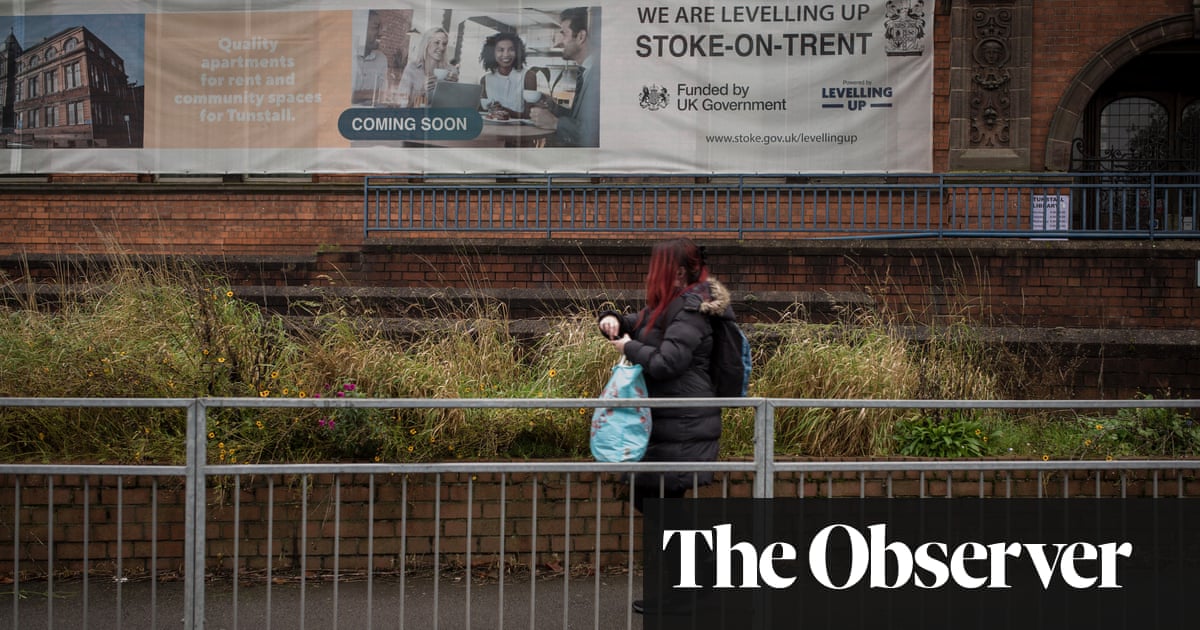
A fund intended to boost the UK’s most deprived places appears overwhelmingly skewed towards Tory-held areas, with dozens of Conservative regions in the top tier for assistance despite being relatively affluent, a Guardian analysis has found.
Among 93 English regions placed in the priority group of three tiers to receive money from the £4.8bn levelling up fund, 31 are included while not being ranked as in the top third most deprived places by average deprivation score.
Of these 31, 26 are entirely represented by Conservative MPs, with the others having at least one Tory MP.
Among the remaining five is Canterbury, is a highly marginal Labour-Conservative seat.
Labour described the way the fund was allocated as “divide and rule”, and called on ministers to publish the criteria for the tiers. One MP whose area was excluded from the top tier called the decision “a stitch-up”.
Four places are in the uppermost level for funding despite being ranked in the bottom third of English regions by deprivation score, the analysis found. All those areas have Conservative MPs.
One area is Richmondshire in North Yorkshire, where the local MP is Rishi Sunak, the chancellor, whose own department is leading work on the fund. This is among the top fifth of most prosperous places in England by the average deprivation score.
The analysis will add weight to complaints about “pork barrel politics” within Sunak’s budget on Wednesday. It included money for two other funds, both of which appear also to lean towards Conservative-held areas.
The chancellor announced £1bn in extra money for an existing towns fund, intended to help struggling areas. Of the 45 new grants unveiled this week, 39 will go to towns with a Conservative MP.
Finally, a community renewal fund, with a total spend of £220m, will also benefit Sunak’s Richmondshire region. In all, seven areas represented by cabinet ministers are among the 100 areas targeted for help.
Dan Jarvis, mayor of the Sheffield city region and the Labour MP for Barnsley Central, said the government’s treatment of the levelling up fund was “symbolic of their divide and rule approach”, noting that while Richmondshire was in the top level, Sheffield and Barnsley – both of which have notably higher deprivation levels – were in tier 2.
Jarvis called for the funding metric to be published: “It’s yet again proof that this government’s actions are levelling South Yorkshire down, pushing our region and some of the poorest places in the north to the back of the queue for investment.”
Paul Dennett, the Labour mayor of Salford, said he could not understand why his city was tier 2 for the fund: “Salford is the 18th most deprived area in the country according to government’s own index of multiple deprivation. We would have fully expected Salford to have been included in category 1.”
While the levelling up fund also covers Scotland and Wales, deprivation statistics between the nations are not directly comparable, meaning the Guardian analysis only covers England.
However, Plaid Cymru’s Westminster leader, Liz Saville Roberts, said she could not understand why Gwynedd, in north-west Wales, which includes her Dwyfor Meirionnydd constituency, was put in the lowest tier for help, saying that earlier EU funds prioritised it as among the least developed areas in Europe.
She said: “Our public money is being snatched for the budget of Tory bungs. This is not levelling up but a stitch-up.”
Boris Johnson was asked on Thursday about the allocation of the towns fund towards Conservative seats, arguing that his party’s win in the 2019 election meant “there are a lot of Conservative-represented towns”.
Speaking to reporters on a visit to Teesport in north-east England, he said: “I’ve asked about this and I’m told that the criteria was entirely objective – it takes in data on poverty, employment and so on.”
The row has been exacerbated by apparent confusion in government over how the decision to allocate spending had been made.
While Sunak had told a post-budget press conference that the metric was “based on an index of economic need, which is transparently published”, an apparent reference to the levelling-up fund, the fund’s official prospectus, says this information is coming “shortly”. Treasury sources were unable to say how long this might be.
A Treasury spokesman said: “The bandings do not represent eligibility criteria – and money will be allocated to the areas most in need. Further technical details will be published by the government in due course.”
The metrics for the towns fund also appear somewhat open to interpretation. While a wider pool of 541 eligible towns was selected based on official deprivation levels, further selection was down to factors including what was called “strategic alignment with government priorities”, investment opportunities, and other indicators of need.
Similarly, the formula for deciding who received money from the community renewal fund was also somewhat qualitative, based on an assessment by the housing ministry of seven “strategic fit considerations”.












